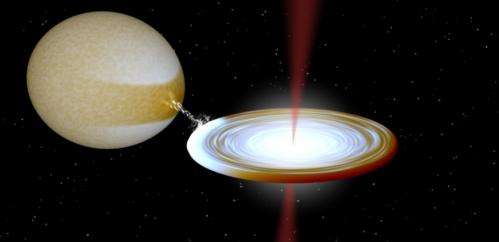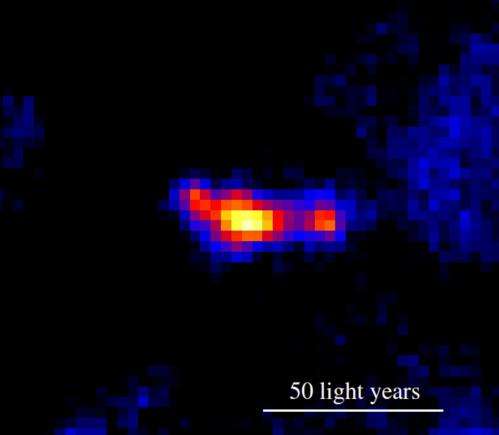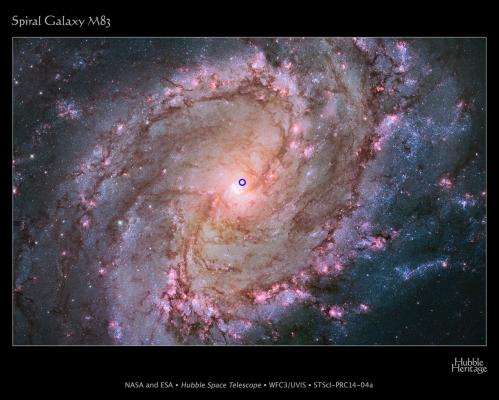A new 'fast and furious' black hole

A black hole with extremely powerful jets has been found in the nearby galaxy Messier 83 (M83) by a team of Australian and American researchers, as we report in the journal Science today.
Black holes are by definition invisible, but when matter falls towards (and then into) them, they turn into a very efficient class of engines.
Chuck in some fuel (any kind of matter will do) and you get a huge amount of energy extracted from it as it falls into the gravitational field of the hole; eventually, the infalling gas crosses the horizon and is lost forever (or not) to our view.
If a car engine could be as energy efficient as a black hole, we could drive to Saturn and back with one litre of petrol (based on typical gasoline combustion efficiency of 45 MJ/kg, compared with the energy released by accretion onto a black hole, about 10 billion MJ/kg).
We don't have black-hole-powered cars because nobody knows how to make pocket-size black holes on Earth (not even the smart folks at CERN).
But Nature has found ways of making black holes and using them as compact sources of energy. The most energetic or most explosive sources in the universe (such as quasars and gamma-ray bursts) are powered by the gravitational field of black holes, not by nuclear fusion (which powers the sun and all other stars).
Exploring black holes (from a distance)
The more we explore the cosmos around us, the more evidence we find of active black holes and the effect they have on their surroundings. The newly-identified object in M83 (named MQ1, as the most energetic microquasar in M83) is the latest, striking example.
The power generated just outside a black hole spreads outwards via two possible channels:

- radiation, such as heat, visible light, UV and X-rays
- "fast jets" made of electrons, positrons and sometimes also atomic nuclei.
Measuring the radiative luminosity is relatively straightforward, thanks to orbiting X-ray telescopes such as Chandra, XMM-Newton and Swift.
Measuring the jet power is more tricky. Jets eventually slam into the surrounding interstellar gas, shocking and heating it, so a black hole with powerful jets tends to be surrounded by an expanding, elongated "bubble" of hot ionised gas and free electrons.
By measuring the size and luminosity (both the optical and radio emission) of this bubble, we estimate the power of the jets and for how long they have been switched on. This is precisely what we did for MQ1 in the M83 galaxy.
We inferred a huge jet power, a few million times higher than the total power of the sun, but similar to a few other black holes discovered in nearby galaxies over the past decade.
So, MQ1 is not a total oddity or an experimental glitch; but it is the only one in its class (so far) for which we can also constrain the mass of the black hole, via X-ray measurements of the radiation emitted by the infalling gas.
Explosions in the sky
We can say with high confidence that MQ1 is a small black hole, probably formed from a stellar collapse, like millions of other in each galaxy – so small and yet so powerful.

The discovery of MQ1 is just one of the results of our comprehensive study of the face-on spiral galaxy M83.
We are mapping this iconic Southern-sky galaxy (well known to Australian stargazers) with the Hubble Space Telescope and Magellan telescope (optical band), the Chandra X-ray Observatory (X-rays), the Australia Telescope Compact Array and the Very Large Array (radio).
We want to understand how stars are formed, evolve and die in a spiral galaxy.
Unlike the comfortable and relaxed state of our own ageing Milky Way, M83 is still young, loud, turbulent, rich of gas and of massive stars that explode as supernovae. (You wouldn't expect otherwise from a galaxy that lends its name to a French electronic band.)
The significance of the huge jet power measured for MQ1 goes beyond this particular galaxy.
It helps us understand and quantify the strong effect that black hole jets have on the surrounding gas, which gets heated and swept away. This must have been a significant factor in the early stages of galaxy evolution, 12 billion years ago, because we have evidence that powerful black holes like MQ1 (rare today) were much more common at the time.
By studying microquasars such as MQ1, we get a glimpse of how the early universe evolved and how fast quasars grew.
Provided by The Conversation
This story is published courtesy of The Conversation (under Creative Commons-Attribution/No derivatives).![]()




















